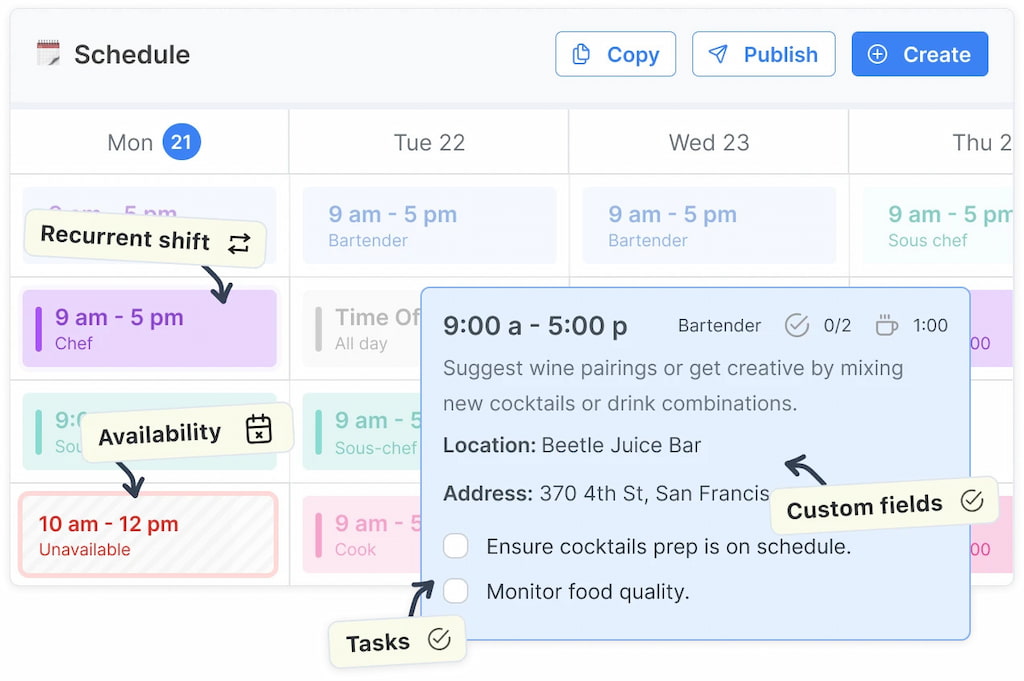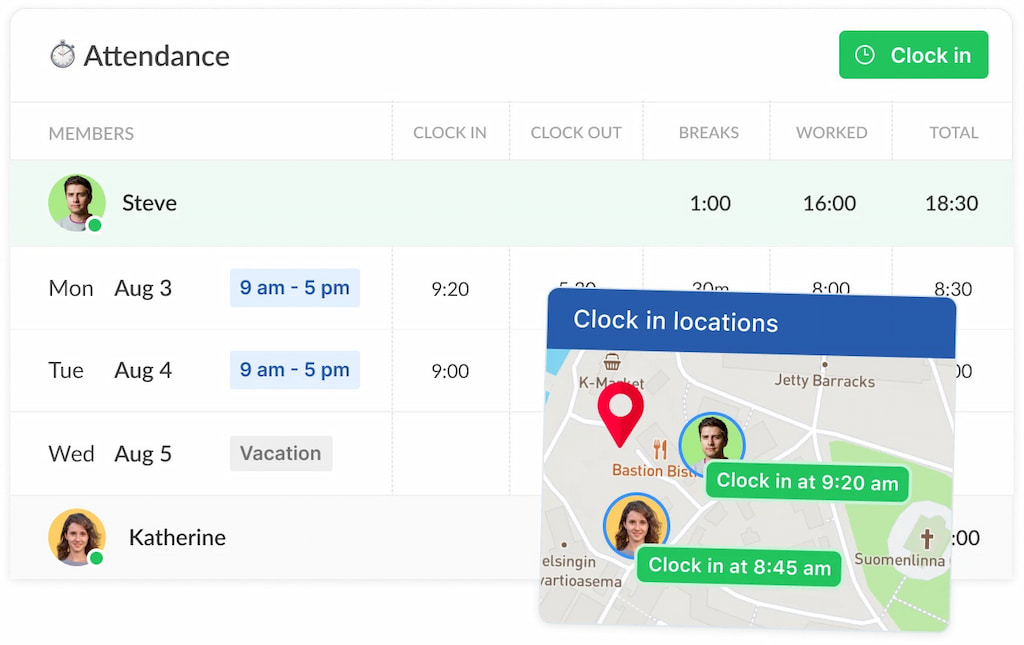Running a retail business means juggling employee schedules, store hours, and changing customer demands—all while keeping operations smooth. That’s where retail scheduling software helps. These tools automate shift planning, track attendance, and reduce scheduling conflicts, giving managers more time to focus on sales and service. Shifts by Everhour stands out as one of the best options, offering easy shift creation, real-time updates, and clear visibility into staff availability. With the right software, retail teams can stay organized, minimize staffing gaps, and maintain consistent coverage across all locations.
🛒 Why Retail Businesses Need Scheduling Software
Managing retail staff schedules manually often leads to confusion, coverage gaps, and wasted time. As teams grow and shifts vary by location or season, spreadsheets and paper rosters simply can’t keep up.
Common issues with manual scheduling
- 📉 Frequent errors and double-booked shifts
- 🕒 Time wasted updating spreadsheets and notifying staff
- ⚠️ Lack of visibility into who’s available or working
- 💬 Miscommunication between managers and employees

How automation changes the game
- ⚡ Saves time: create and update schedules in minutes with templates and drag-and-drop tools
- ✅ Reduces errors: the system automatically detects conflicts, overtime, and open shifts
- 👁️ Improves coverage: managers can instantly see gaps and assign replacements
Positive impact on your team and customers
- 😊 Happier employees: staff can view and swap shifts easily through the app
- 🛍️ Better service: consistent coverage means smoother operations and more satisfied customers
With modern scheduling tools and best retail scheduling practices, retail managers can focus less on logistics and more on driving sales and improving the customer experience.
⚙️ Key Features to Look For in Retail Scheduling Tools
When choosing a scheduling tool for your retail business, look for features that simplify management, improve accuracy, and keep your team aligned:
- 🗓️ Shift planning and automation: Quickly create, copy, and adjust shifts with templates and recurring schedules.
- ⚡ Real-time notifications and shift swapping: Instantly alert staff to changes and allow swaps without confusion.
- ⏱️ Time tracking and payroll integration: Monitor hours worked and streamline payroll for accuracy and compliance.
- 📱 Mobile access for on-the-go management: Managers and employees can view schedules, trade shifts, and receive updates from anywhere.
- 📊 Reporting and labor cost insights: Track attendance, overtime, and staffing expenses to make smarter decisions.
- 🌐 Multi-location support: Easily manage teams across multiple stores or branches from one platform.
🤔 Best Retail Scheduling Software Breakdown
| Tool | Key Features | Pricing | Ideal For |
|---|---|---|---|
| Shifts by Everhour | Shift automation, real-time notifications, mobile access, reporting | Free plan; Starts at $5/user/month | Small to large retail teams needing flexible scheduling |
| Deputy | Shift planning, attendance tracking, labor compliance | Starts at $2/user/month | Multi-location retail operations |
| 7shifts | Employee scheduling, time clock, labor cost management | Free plan available, paid from $17.99/location/month | Restaurants and small retail stores |
| Homebase | Scheduling, time tracking, team messaging | Free plan available, paid from $14/location/month | Small retail teams |
| When I Work | Shift scheduling, team messaging, time tracking | Free for small teams, paid from $2/user/month | Retail stores needing mobile scheduling |
| Humanity | Schedule automation, reporting, leave management | Starts at $3/user/month | Mid-sized retail operations |
| Connecteam | Scheduling, time tracking, task management, chat | Free plan, paid from $39/month | Retail teams with mobile-first needs |
| ZoomShift | Shift scheduling, time clock, notifications | Starts at $2/user/month | Small to medium retail businesses |
| HotSchedules | Scheduling, labor management, analytics | Contact for pricing | High-volume retail operations |
| TrackSmart | Shift management, attendance, reporting | Contact for pricing | Retail chains needing detailed reporting |
🛠️ Tool Breakdown
- Shifts by Everhour: Flexible scheduling, real-time notifications, reporting dashboards, mobile access.
- Deputy: Best for multi-location retail, labor compliance tracking.
- 7shifts: Affordable for small retail teams, intuitive interface.
- Homebase: Free plan for small teams, simple mobile scheduling.
- When I Work: Great for mobile-first scheduling and messaging.
- Humanity: Advanced leave and reporting features for mid-sized stores.
- Connecteam: All-in-one mobile solution for scheduling and team communication.
- ZoomShift: Easy-to-use shift planning and time tracking for small businesses.
- HotSchedules: High-volume retail scheduling with analytics.
- TrackSmart: Detailed reporting and compliance for larger retail chains.
🛒 How Shifts by Everhour helps retail teams
Imagine this: it’s Saturday morning, the store is filling up, and a few staff members call in sick. Chaos, right? Shifts by Everhour ensures this never happens. It keeps your team aligned, informed, and working efficiently.
Key benefits at a glance
- 📅 Simplified shift planning: Drag-and-drop scheduling, recurring templates, and open shift alerts make creating rosters fast and accurate.

- ⚡ Real-time updates & reminders: Instant notifications for shift changes, swaps, or confirmations keep everyone on the same page.
- ⏱️ Attendance & labor tracking: Know who’s clocked in, hours worked, and avoid overtime surprises.

- 💬 Transparent communication: Team members can view schedules, pick up shifts, and message in-app—no endless calls or texts.
- 📝 Reduced admin workload: Automates updates, shift assignments, and notifications so managers spend less time on spreadsheets.
With Shifts by Everhour, retail managers can focus on what matters—serving customers and keeping the store running smoothly—while the software handles the scheduling headaches.
🛍️ How to Choose the Right Software for Your Store
Selecting the right retail scheduling software isn’t just about features—it’s about finding a solution that fits your team, budget, and operations. Here’s what to focus on:
- 👥 Team size, budget, and locations: Make sure the software can handle your number of employees and multiple store locations, while staying within budget.
- 📱 Ease of use and mobile features: Your managers and staff should be able to access schedules, swap shifts, and get notifications on-the-go without frustration.
- 💳 Integration with payroll and POS systems: Look for tools that sync hours and labor costs with payroll or your point-of-sale system, reducing manual work and errors.
Choosing the right software ensures smooth scheduling, fewer headaches for managers, and a better experience for your employees.
❓ FAQ
What is retail scheduling software?
Retail scheduling software helps store managers plan shifts, track hours, and communicate with staff efficiently, replacing spreadsheets and manual schedules.
Why is scheduling software important for retail businesses?
It saves time, reduces errors, improves coverage, and boosts employee satisfaction, which leads to better customer service.
Can I manage multiple store locations with scheduling software?
Yes, most modern tools, including Shifts by Everhour, allow you to schedule staff across multiple locations from a single platform.
Does retail scheduling software integrate with payroll systems?
Many solutions, including Shifts, sync labor hours and attendance with payroll, saving time and reducing errors.
Can employees swap shifts using the software?
Yes, real-time shift swapping and notifications help staff manage their availability without manager intervention.
Is mobile access available for managers and employees?
Absolutely. Mobile apps let managers update schedules on the go and employees check shifts, clock in, or receive notifications anywhere.
How do I choose the best retail scheduling software?
Consider your team size, store locations, budget, mobile usability, and integration with payroll or POS systems.
🧠 Best Retail Scheduling Software: Final Thoughts
Effective retail scheduling goes beyond filling shifts—it ensures coverage, reduces errors, and keeps both staff and customers happy. Tools like Shifts by Everhour make planning, tracking, and communicating shifts easier, saving time and improving team efficiency. Choosing the right scheduling software helps your store run smoothly and keeps your employees engaged.

